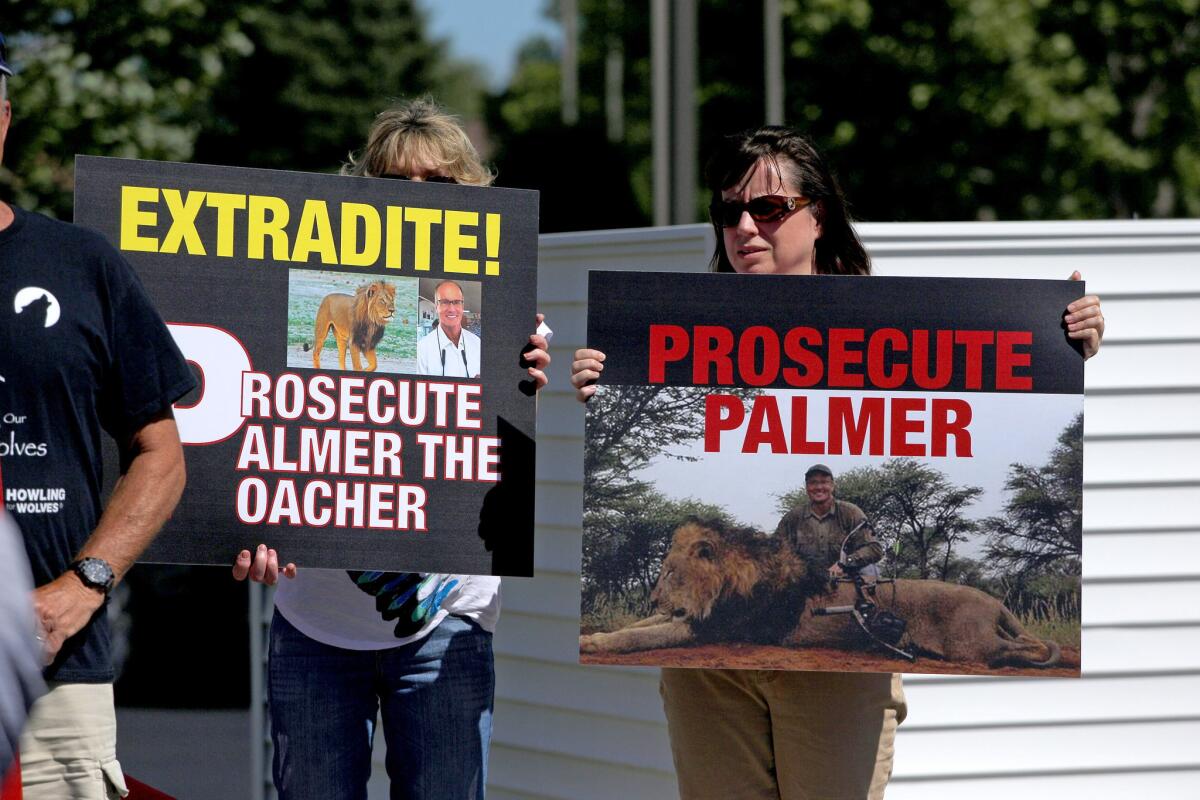Zimbabwe to seek extradition of American dentist who killed Cecil the lion

Protesters gather in the parking lot of Walter Palmer’s River Bluff Dental Clinic in Bloomington, Minn.
- Share via
— Zimbabwe will seek the extradition of Walter James Palmer, the Minnesota dentist who killed an iconic lion outside the perimeter of Hwange National Park in early July, a Zimbabwe Cabinet minister said Friday.
Oppah Muchinguri, the minister, said that the country was taking the issue seriously.
“We have certain processes that we have to follow where I think the police will have to take the first step then they will approach the prosecutor general’s office who will approach the American government,” Muchinguri said.
“I understand that already the processes have started, and we are looking forward for his extradition.”
NEWSLETTER: Get the day’s top headlines from Times Editor Davan Maharaj >>
She also said she was pleased that nearly 500,000 people had called for the extradition of Palmer on Facebook.
“We need that support because this is the route that we are taking as Zimbabwe,” she said. It was the first official response from Zimbabwe on the killing of Cecil the lion.
While the U.S Justice Department and the U.S. Fish and Wildlife Service said Friday that they were investigating the killing of the lion, it appeared unlikely that Palmer would be either charged in the U.S. or extradited to Zimbabwe.
Cecil, known internationally for his distinctive black mane, was allegedly lured out of his protected reserve in Zimbabwe and then shot by Palmer. Palmer, driven into hiding by U.S. protesters, admits killing the lion but said his guides told him it was a legal hunt.
The Fish and Wildlife Service also said Friday that it had been contacted by a representative of Palmer’s after previous attempts to reach him were unsuccessful.
“Late yesterday afternoon the U.S. Fish and Wildlife Service Office of Law Enforcement was contacted by a representative of Dr. Walter Palmer,” the agency said in a statement. “The service’s investigation is ongoing and appreciates that Dr. Palmer’s representative voluntarily reached out to the service.”
The Justice Department confirmed that an investigation was underway but declined to comment on the Zimbabwean government’s assertion that it intends to seek to extradite Palmer under a treaty signed by both countries.
But the U.S. has rarely if ever extradited a citizen on wildlife charges.
The African lion is not currently protected by the U.S. Endangered Species Act, though the wildlife service has proposed listing it. It is protected under another law, the Lacey Act, but U.S. citizens have not been prosecuted under that law unless they bring parts of the animal into the U.S.
Palmer apparently did not bring any part of Cecil home.
News that Palmer had killed Cecil spread after the Zimbabwe Conservation Task Force, a local conservation activist group, alleged that the guides spotted Cecil inside the national park and tied a dead animal to their vehicle to lure the lion out. Then Palmer shot Cecil with a bow and arrow, wounding him.
Palmer and his guides tracked the wounded lion for 40 hours, the group said, before shooting him dead with a gun.
Two Zimbabweans who arranged Palmer’s hunt, landowner Honest Trymore Ndlovu and professional hunter Theo Bronkhorst, face charges there.
Bronkhorst, speaking publicly for the first time about the hunt, told Britain’s Daily Telegraph that things went wrong from the beginning.
“When Dr. Palmer arrived in Bulawayo, his luggage was missing and I was dashing around looking for it. So we were late getting ready to go,” he said. “And we were never meant to hunt on the land where this lion was shot.”
After Cecil was dead, the hunters saw that it had a collar with an electronic tracking device. “I could not have seen the collar at night. We would never shoot a collared animal. I was devastated,” Bronkhorst told the Telegraph. “And so was the client .... I panicked and took it off and put it in a tree.”
Meanwhile, Sen. Bob Menendez (D-N.J.) said he would introduce legislation to curb trophy killings of species that are proposed to be listed as threatened or endangered under the Endangered Species Act of 1973.
The name of his proposed legislation is the Conserving Ecosystems by Ceasing the Importation of Large (or CECIL) Animal Trophies Act.
“Cecil’s death was a preventable tragedy that highlights the need to extend the protections of the Endangered Species Act,” Menendez said in a statement.
In 2014, the Fish and Wildlife Service proposed listing the lion as threatened under the Endangered Species Act, with a special rule that would permit the importation of sport-hunted lion trophies, provided that the lions originate from countries with a scientifically sound management plan for African lions.
Laury Parramore, a wildlife service representative, said the public comment period for the proposal to include lions as a threatened species closed in late January, and the service was working on a final rule. The process generally takes a year to complete.
Twitter: @natalieschachar, @timphelpsLAT
MORE ON CECIL THE LION:
Outraged over Cecil the lion? It may help you understand the rage over Planned Parenthood
Jimmy Kimmel mourns Cecil the Lion, lashes out at animal’s killer
The lion, the dentist and the fury: A viral storm
More to Read
Sign up for Essential California
The most important California stories and recommendations in your inbox every morning.
You may occasionally receive promotional content from the Los Angeles Times.













